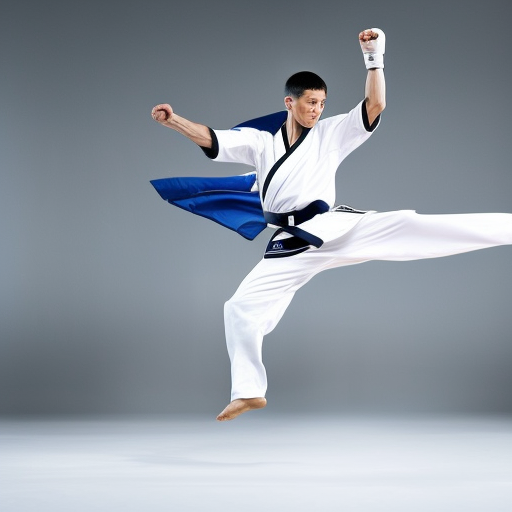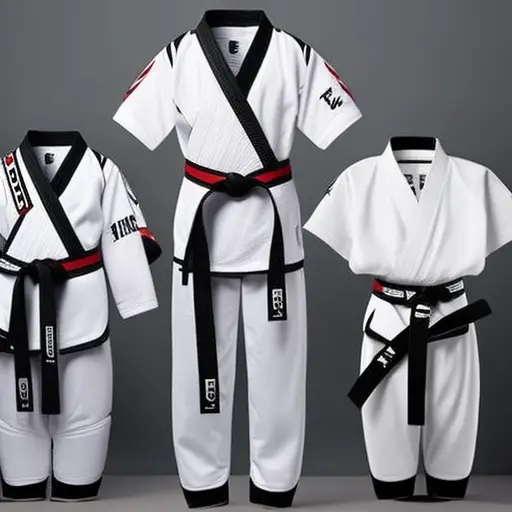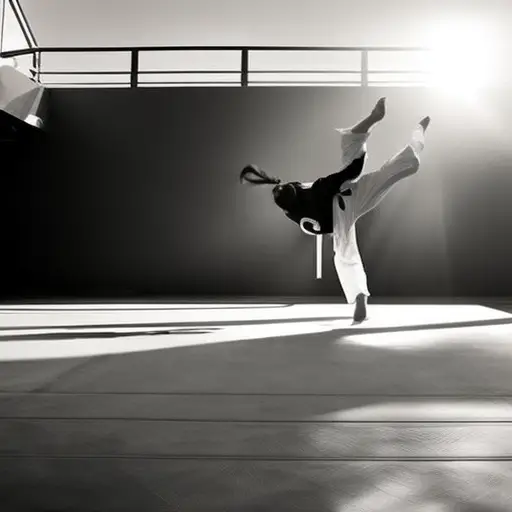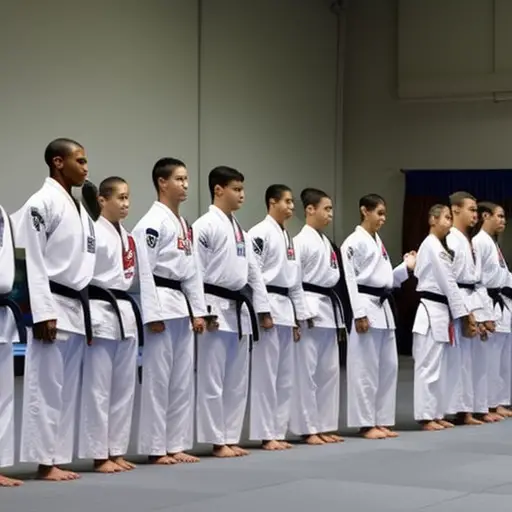Breaking Down the Basic Taekwondo Kicks

Taekwondo, a martial art originating from Korea, is renowned for its powerful and precise kicks. In this article, we will delve into the intricacies of the basic taekwondo kicks, breaking them down step-by-step.
With a disciplined approach, we will explore the mechanics and techniques behind each kick, including the roundhouse kick, front kick, side kick, back kick, axe kick, hook kick, and crescent kick.
By unraveling these fundamental movements, we aim to provide a comprehensive understanding of taekwondo’s dynamic kicking techniques.
Roundhouse Kick
The roundhouse kick is a fundamental technique in Taekwondo that involves striking the target with the top of the foot in a circular motion. This kick is renowned for its power and speed, making it a formidable weapon in any Taekwondo practitioner’s arsenal. The roundhouse kick is executed by pivoting on the supporting foot, rotating the hips, and driving the kicking leg outward. This motion generates significant momentum, allowing the foot to strike with force.
The target of the roundhouse kick is typically the midsection or head of an opponent, and its circular trajectory adds to its effectiveness, making it difficult to defend against. However, despite its effectiveness, the roundhouse kick is not without its common mistakes.
One of the most prevalent errors is telegraphing the kick by dropping the hands or winding up the leg too obviously before executing the strike. This gives opponents a warning and time to counter. Another mistake is failing to retract the leg quickly after the kick, leaving the practitioner vulnerable to attacks. Lastly, improper alignment of the supporting leg can lead to a loss of balance and reduced power.
Transitioning into the subsequent section about the ‘front kick’, it is important to note that the roundhouse kick is often used in combination with other kicks to create a varied and unpredictable offensive strategy in Taekwondo.
Front Kick
One of the key components of a Taekwondo practitioner’s arsenal is the front kick, which combines speed, precision, and power to deliver a devastating strike. The front kick is a fundamental technique that requires proper form and technique to be executed effectively.
There are several variations of the front kick that can be used depending on the situation and target selection. The most basic form of the front kick is the front snap kick. This kick involves thrusting the ball of the foot forward, with the toes pulled back, to strike the target. The target selection for the front snap kick can vary depending on the practitioner’s intent. It can be aimed at the torso, the head, or even the groin area for self-defense purposes.
Another variation of the front kick is the front push kick. This kick involves extending the leg straight out and using the ball of the foot to push the target away. The front push kick can be used to create distance between the practitioner and the opponent, or to disrupt the opponent’s balance.
Side Kick
When it comes to the side kick in Taekwondo, there are two main points to consider.
The first is the execution and technique of the kick, which involves proper alignment of the body, hip rotation, and extension of the leg.
The second point is the various applications and variations of the side kick, including its use in self-defense, sparring, and breaking techniques.
Execution and Technique
How can a practitioner effectively execute the side kick in Taekwondo with proper technique?
The side kick is a fundamental and powerful kick in Taekwondo, requiring precise execution and technique.
To effectively execute a side kick, practitioners must first understand targeting strategies and power generation. Proper targeting involves aiming for the opponent’s midsection or head, maximizing the impact and potential knockdown effect.
Additionally, power generation is crucial in executing a strong side kick. This can be achieved by utilizing the rotation of the hips and torso, while keeping the supporting leg stable and grounded. By generating power from the core and transferring it through the leg, practitioners can deliver a forceful side kick.
Understanding these aspects of execution and technique sets the foundation for exploring the various applications and variations of the side kick in Taekwondo.
Applications and Variations
To fully explore the versatility and effectiveness of the side kick in Taekwondo, practitioners can delve into its applications and variations.
The side kick is a powerful and versatile kicking technique that can be used in various situations. One of the main applications of the side kick is for long-range attacks. Its extended reach and power make it an effective tool for keeping opponents at bay.
Additionally, the side kick can also be used for close-range strikes, such as targeting an opponent’s knee or groin area. This allows practitioners to disable their opponents quickly and efficiently.
Variations of the side kick include the sliding side kick and the spinning side kick, which require different training methods to develop the necessary speed, balance, and control. The sliding side kick involves sliding the supporting foot forward while executing the kick, increasing the power and reach of the technique.
The spinning side kick, on the other hand, involves spinning the body before executing the kick, adding a rotational force to the strike. This variation is often used for surprise attacks or to counter an opponent’s movement.
Back Kick
The back kick is a powerful and effective technique in Taekwondo, utilizing the momentum generated by the practitioner’s twisting motion. It requires precise execution and technique to deliver maximum impact.
Target selection and accuracy are crucial, as striking with the heel can cause significant damage.
Additionally, understanding counterattacks and defense strategies is essential to effectively utilize the back kick in combat situations.
Technique and Execution
During the execution of a back kick in Taekwondo, the practitioner must maintain proper technique and focus on precision. The back kick is a powerful technique that can be used in various applications and variations. It is essential for the practitioner to select the right target and execute the kick with accuracy to maximize its effectiveness.
In terms of applications and variations, the back kick can be used as a defensive move to counter an attack from behind. It can also be utilized as an offensive move to strike the opponent’s lower body, such as the groin or abdomen. Additionally, the back kick can be incorporated into combinations or performed as a spinning kick for added surprise and impact.
Target selection is crucial when executing a back kick. The practitioner should aim for vulnerable areas such as the solar plexus or the floating ribs to disable the opponent effectively. Accuracy is paramount to ensure that the kick lands with full force and precision, maximizing its potential to incapacitate the adversary.
Target Selection and Accuracy
Target selection is a critical aspect of executing a back kick in Taekwondo, and accuracy plays a vital role in its effectiveness. In order to deliver a powerful and accurate back kick, taekwondo practitioners must focus on target control, precision and timing, as well as power and speed. By selecting the right target, such as the opponent’s abdomen or solar plexus, the practitioner can maximize the impact of their kick. Precision and timing are crucial in order to land the kick accurately and effectively. Additionally, the power and speed of the kick contribute to its overall effectiveness. A well-executed back kick can deliver a devastating blow, making target selection and accuracy essential for success in Taekwondo.
| Target Control | Precision and Timing |
|---|---|
| – Selecting the right target maximizes impact | – Accurate execution is crucial |
| – Focus on opponent’s vulnerable areas | – Proper timing ensures effectiveness |
| – Aim for abdomen or solar plexus | – Landing the kick accurately is key |
| Power and Speed |
|---|
| – Deliver a powerful blow |
| – Generate speed for maximum impact |
| – Proper technique enhances power |
Counterattacks and Defense
Executing a well-timed back kick, taekwondo practitioners can effectively counterattack and defend against their opponents. This powerful kick involves striking the target with the heel of the foot, making it a formidable tool in combat situations.
When it comes to counterattacks and defense, taekwondo practitioners rely on specific techniques and maneuvers to protect themselves. Here are three key strategies used in taekwondo for counterattacks and defense:
-
Block techniques: Taekwondo practitioners employ various block techniques to intercept and neutralize an opponent’s attacks. These blocks involve using the arms, legs, or even the body to stop or redirect the incoming strike.
-
Evasive maneuvers: Taekwondo emphasizes agility and quick footwork, allowing practitioners to evade oncoming attacks. By swiftly moving out of the way or sidestepping, they can avoid getting hit and create opportunities for counterattacks.
-
Back kick as a defensive technique: The back kick itself can also serve as a defensive move. By executing a back kick, taekwondo practitioners can create distance between themselves and their opponent, deterring further attacks.
Transitioning into the subsequent section about the ‘axe kick’, taekwondo practitioners utilize a different technique that involves striking downward with the heel of the foot.
Axe Kick
The Axe Kick is a powerful and dynamic technique used in Taekwondo to strike downward with the heel of the foot. It is a highly effective offensive move that can be executed with precision and speed.
To perform the axe kick, the practitioner raises their leg up high, with the knee bent, and then extends the leg straight up into the air before bringing it down forcefully with the heel. This downward strike can be aimed at various targets such as the head, shoulder, or even the collarbone of an opponent.
There are several variations of the axe kick that can be utilized in different situations. One variation is the jumping axe kick, where the practitioner jumps into the air before executing the kick. This adds momentum and power to the strike, making it even more devastating.
Another variation is the spinning axe kick, which involves spinning the body while executing the kick. This can catch opponents off guard and create opportunities for counterattacks.
Hook Kick
The hook kick is a dynamic and versatile technique that combines speed and precision to strike opponents from unexpected angles. It is a highly effective move in Taekwondo that can catch opponents off guard and deliver a powerful blow.
Here are three key aspects of the hook kick technique and its application:
-
Body rotation: The hook kick relies on the rotation of the body to generate power. As you lift your leg, twist your hips and torso in the direction of your target. This rotation adds momentum to the kick and increases its force.
-
Target selection: The hook kick is best utilized when targeting the head or torso of your opponent. Aim for the side of their face or body, as this is where the kick can have the most impact. The element of surprise, combined with the speed and power of the hook kick, can make it difficult for your opponent to defend against.
-
Counterattacks: The hook kick can also be used as a counterattack. By timing your kick correctly, you can intercept your opponent’s attack and strike them simultaneously. This requires precise timing and anticipation of your opponent’s movements.
Mastering the hook kick technique and understanding its application in different situations will greatly enhance your offensive capabilities in Taekwondo. Practice diligently to develop speed, accuracy, and timing in executing this powerful kick.
Crescent Kick
How can the crescent kick be effectively utilized in Taekwondo, and what are its key components? The crescent kick is a powerful and versatile technique commonly used in Taekwondo. It involves a circular motion of the leg, creating a crescent-shaped trajectory as it strikes the target. This kick can be used to attack an opponent’s head, torso, or legs, making it an essential tool in a practitioner’s arsenal.
To perform a crescent kick, the athlete must first raise their knee to the desired height, then extend the leg outward. As the leg reaches its highest point, the foot should start to curve inwards, creating the crescent shape. The striking surface is usually the instep or the ball of the foot, depending on the target area.
Here is a table summarizing the key components of the crescent kick technique and common mistakes to avoid:
| Key Components | Common Mistakes |
|---|---|
| Raise knee to height | Lack of knee elevation |
| Extend leg outward | Inadequate leg extension |
| Curve foot inwards | Failure to curve foot |
| Strike with instep/ball | Incorrect striking surface |
| Maintain balance | Lack of control |
Frequently Asked Questions
How Can I Improve My Balance and Flexibility to Execute the Taekwondo Kicks Effectively?
Improving balance and increasing flexibility are crucial for executing taekwondo kicks effectively. To enhance balance, focus on core strength and proprioception exercises. For flexibility, incorporate dynamic and static stretching routines into your training regimen.
Can Practicing Taekwondo Kicks Help in Self-Defense Situations?
Practicing taekwondo kicks can be beneficial for self-defense as it enhances agility, power, and coordination. However, it is crucial to emphasize the importance of proper technique in executing these kicks effectively in real-life self-defense situations.
Are There Any Common Mistakes That Beginners Make While Performing Taekwondo Kicks?
Beginners in Taekwondo often make common mistakes while performing kicks. To avoid these errors, proper training and guidance are essential. By focusing on correct form, balance, and technique, beginners can improve their kicks and minimize mistakes.
Does the Execution of Taekwondo Kicks Require a Lot of Upper Body Strength?
The execution of taekwondo kicks does not necessarily require a lot of upper body strength. However, proper technique is crucial for effective kicks. Building lower body strength through specific exercises can enhance the power and precision of the kicks.
Can Taekwondo Kicks Be Modified or Adapted for People With Physical Limitations or Disabilities?
Modified kicks and adaptive techniques in Taekwondo allow for individuals with physical limitations or disabilities to participate in the sport. These modifications can be tailored to accommodate specific needs, ensuring inclusivity and accessibility for all practitioners.
Conclusion
In conclusion, the various kicks in taekwondo demonstrate the discipline and precision required in this martial art.
From the powerful roundhouse kick to the swift front kick, each technique serves a specific purpose and requires extensive training to master.
As the ancient adage goes, ‘practice makes perfect,’ and this rings true for taekwondo practitioners who strive to perfect their kicks through dedicated practice and unwavering determination.





